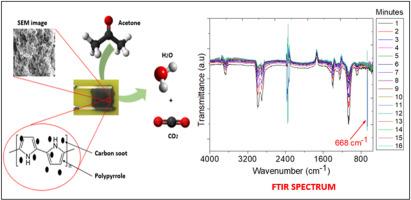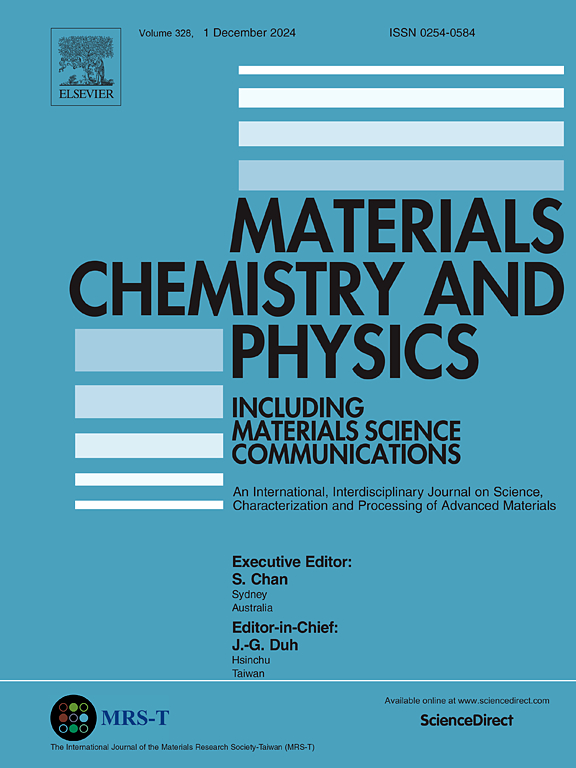使用室温下工作的CNPs/聚吡咯固态传感器检测挥发性有机化合物
IF 4.3
3区 材料科学
Q2 MATERIALS SCIENCE, MULTIDISCIPLINARY
引用次数: 0
摘要
在这项工作中,我们报告了使用碳纳米颗粒(CNPs),通常作为碳烟,因为它们是由灯塔蜡烛,聚吡咯(PPy)和碳nanoparticles@polypyrrole (CNPs@PPy)复合传感器热解制备的,用于在室温下检测挥发性有机化合物。制作了5个传感器,其中仅由PPy组成的第一个传感器命名为传感器1,仅由CNPs组成的传感器2;传感器3由1:1质量比的CNPs@PPy组成,传感器4由2:1质量比的CNPs@PPy组成,传感器5分别由3:1质量比的CNPs@PPy组成。传感器使用丙酮、2-丙醇、乙醇和三甲苯蒸气进行动态测试。在所有测试的传感器中,与传感器相比,传感器5对分析物的灵敏度有所提高;由于复合材料中CNPs的数量发生了变化,传感器5对丙酮蒸气的灵敏度高于2-丙醇、乙醇和亚甲基甲苯蒸气。传感器5对丙酮蒸汽的响应时间和恢复时间分别为72 s和110 s,检出限(LOD)为1.212 ppm。传感器5显示,随着湿度的增加,丙酮蒸气略有增加。采用原位傅里叶变换红外光谱(FTIR)结合LCR仪对传感器5的气敏机理进行了研究;基本上,丙酮蒸汽与固态气体传感器相互作用,提供0.5 V, 25 kHz。该装置证实丙酮完全分解成二氧化碳(CO2)。还证实了CO2波段强度随着丙酮蒸气与传感器之间暴露时间的增加而增加。本文章由计算机程序翻译,如有差异,请以英文原文为准。

The detection of volatile organic compounds using a CNPs/polypyrrole-based Solid-State sensor operating at room temperature
In this work, we report the use of carbon nanoparticles (CNPs), commonly as carbon soot, as they are prepared from the pyrolysis of lighthouse candle, polypyrrole (PPy) and carbon nanoparticles@polypyrrole (CNPs@PPy) composite sensors to detect volatile organic compounds at room temperature. Five sensors were fabricated wherein the first sensor was made up of PPy only was named sensor 1, sensor 2 was made up of CNPs only; sensor 3 was made up of a 1:1 mass ratio of CNPs@PPy, sensor 4 was made up of a 2:1 mass ratio of CNPs@PPy, and sensor 5 was fabricated using a 3:1 mass ratio of CNPs@PPy respectively. The sensors were tested dynamically using acetone, 2-propanol, ethanol, and mesitylene vapours. Among all the tested sensors, sensor 5 showed improved sensitivity towards the analytes as compared to sensors; sensor 5 showed higher sensitivity towards acetone vapour than 2-propanol, ethanol, and mesitylene vapours because of a changed amount of CNPs within the composite. The response and recovery times of sensor 5 towards acetone vapour were 72 and 110 s, respectively and a limit of detection (LOD) of 1.212 ppm. Sensor 5 showed a slight increase in acetone vapour as humidity increased. The gas sensing mechanism on sensor 5 was studied using an in situ Fourier Transform infrared spectroscopy (FTIR) combined with an LCR meter; basically, the acetone vapour interacts with the solid-state gas sensor supplied with 0.5 V at 25 kHz. The setup confirmed that the acetone completely decomposes into carbon dioxide (CO2). It was also confirmed that the CO2 band intensity increases as the exposure time between the acetone vapour and the sensor increases.
求助全文
通过发布文献求助,成功后即可免费获取论文全文。
去求助
来源期刊

Materials Chemistry and Physics
工程技术-材料科学:综合
CiteScore
8.70
自引率
4.30%
发文量
1515
审稿时长
69 days
期刊介绍:
Materials Chemistry and Physics is devoted to short communications, full-length research papers and feature articles on interrelationships among structure, properties, processing and performance of materials. The Editors welcome manuscripts on thin films, surface and interface science, materials degradation and reliability, metallurgy, semiconductors and optoelectronic materials, fine ceramics, magnetics, superconductors, specialty polymers, nano-materials and composite materials.
 求助内容:
求助内容: 应助结果提醒方式:
应助结果提醒方式:


